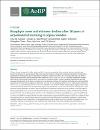Bryophyte cover and richness decline after 18 years of experimental warming in alpine Sweden.
| المؤلف | Alatalo, Juha M |
| المؤلف | Jägerbrand, Annika K |
| المؤلف | Erfanian, Mohammad Bagher |
| المؤلف | Chen, Shengbin |
| المؤلف | Sun, Shou-Qin |
| المؤلف | Molau, Ulf |
| تاريخ الإتاحة | 2021-01-28T06:40:41Z |
| تاريخ النشر | 2020-12-01 |
| اسم المنشور | AoB PLANTS |
| المعرّف | http://dx.doi.org/10.1093/aobpla/plaa061 |
| الاقتباس | Juha M Alatalo, Annika K Jägerbrand, Mohammad Bagher Erfanian, Shengbin Chen, Shou-Qin Sun, Ulf Molau, Bryophyte cover and richness decline after 18 years of experimental warming in alpine Sweden, AoB PLANTS, Volume 12, Issue 6, December 2020, plaa061, https://doi.org/10.1093/aobpla/plaa061 |
| الملخص | Climate change is expected to affect alpine and Arctic tundra communities. Most previous long-term studies have focused on impacts on vascular plants, this study examined impacts of long-term warming on bryophyte communities. Experimental warming with open-top chambers (OTCs) was applied for 18 years to a mesic meadow and a dry heath alpine plant community. Species abundance was measured in 1995, 1999, 2001 and 2013. Species composition changed significantly from original communities in the heath, but remained similar in mesic meadow. Experimental warming increased beta diversity in the heath. Bryophyte cover and species richness both declined with long-term warming, while Simpson diversity showed no significant responses. Over the 18-year period, bryophyte cover in warmed plots decreased from 43 % to 11 % in heath and from 68 % to 35 % in meadow (75 % and 48 % decline, respectively, in original cover), while richness declined by 39 % and 26 %, respectively. Importantly, the decline in cover and richness first emerged after 7 years. Warming caused significant increase in litter in both plant communities. Deciduous shrub and litter cover had negative impact on bryophyte cover. We show that bryophyte species do not respond similarly to climate change. Total bryophyte cover declined in both heath and mesic meadow under experimental long-term warming (by 1.5-3 °C), driven by general declines in many species. Principal response curve, cover and richness results suggested that bryophytes in alpine heath are more susceptible to warming than in meadow, supporting the suggestion that bryophytes may be less resistant in drier environments than in wetter habitats. Species loss was slower than the decline in bryophyte abundance, and diversity remained similar in both communities. Increased deciduous shrub and litter cover led to decline in bryophyte cover. The non-linear response to warming over time underlines the importance of long-term experiments and monitoring. |
| اللغة | en |
| الناشر | Oxford University Press |
| الموضوع | Climate change global warming mosses plant litter plant–climate interactions plant–plant interactions species richness |
| النوع | Article |
| رقم العدد | 6 |
| رقم المجلد | 12 |
| ESSN | 2041-2851 |
الملفات في هذه التسجيلة
هذه التسجيلة تظهر في المجموعات التالية
-
مجموعة علوم الغلاف الجوي [42 items ]


